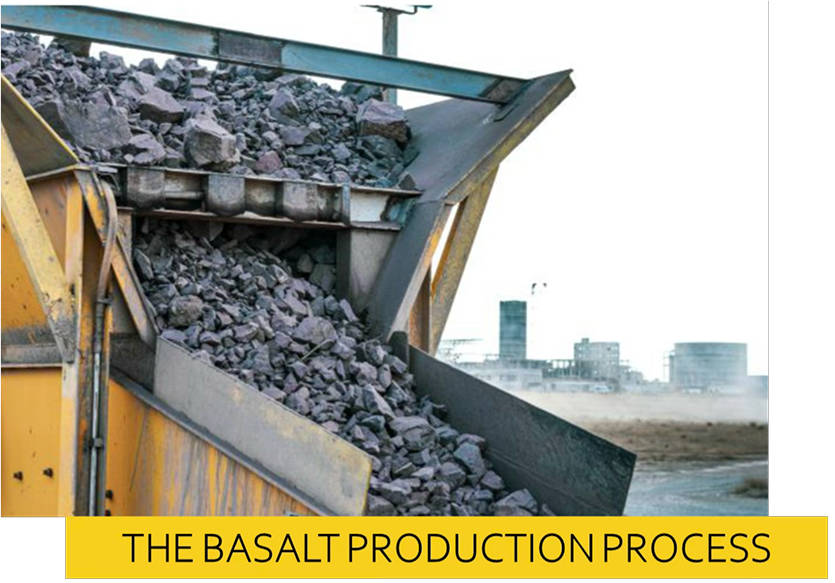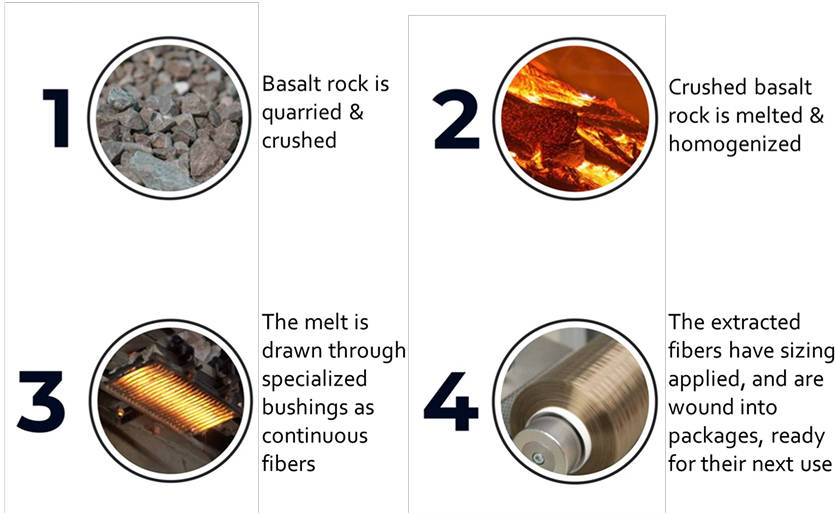Our Insights
Basalt is a dark, fine-grained igneous rock formed from the rapid cooling of lava at or near the Earth's surface, often during volcanic eruptions. It's one of the most common types of rock on Earth and makes up much of the ocean floor as well as large areas of the continents.
Naturally dense and durable, basalt is composed primarily of silicate minerals like pyroxene and plagioclase. It's prized for its high strength, chemical stability, and resistance to heat and weathering, making it useful in everything from building stone and road base to insulation and industrial applications.
Because basalt is abundant, non-toxic, and entirely natural, t has become an attractive raw material for modern composite technologies-including basalt fiber, which is made by melting and extruding basalt rock into continuous or chopped strands.


Basalt Fiber is made from extremely fine fibers composed of plagioclase, pyroxene, and olivine. It is similar to carbon fiber and fiberglass, having better physical and mechanical properties than fiberglass but significantly cheaper than carbon fiber. It is used in construction and infrastructure, and as a fireproof textile in the aerospace and automotive industries and can also be used as a composite to produce a wide variety of products.
Basalt Fiber is produced from crushed basalt sourced from a carefully chosen quarry. Unlike materials such as glass fiber, it contains virtually no additives. The basalt is washed before being melted down. Producing basalt fiber involves melting the quarried basalt rock. The molten rock is extruded through small nozzles to create continuous filaments of basalt fiber. These fibers typically have a filament diameter ranging from 9 to 17 microns, and they exhibit a high elastic modulus, resulting in exceptional specific strength that is three to four times that of steel.
To produce Basalt Continuous Fiber (BCF) a single-component, nature prepared, environmentally friendly raw material is used - basalt rocks. Unlike competing materials, there is zero waste in the production process: One ton of rock produces one ton of fiber.
BCF production is single-step process as nature has already performed the primary enrichment, melting and homogenization of basalt. Basalt is heated and melted in the furnace only once, which makes it possible to obtain the required product - BCF, with a minimum of energy consumption. Further processing of BCF into materials is carried out using "cold technologies".
BCF production technologies are environmentally friendly, energy-saving and rely on nanotechnology to ensure the production of continuous fibers with diameters of 9 - 17 microns and length up to 60 km, with high specifications in terms of strength, elasticity, chemical and thermal resistance.
Basalt International has manufacturing capability and partners all over the world, has an experienced leadership team, and has the mission to provide the standard or custom products for your project.
Basalt is a "miracle material" that's special in so many ways, including:
- Superior Thermal Protection.Our Basalt has a thermal range of -260 °C to +982 °C (1800°F) and a melting point of 1450 °C. Fibers are ideal for fire protection and insulating applications.
- Basalt fibers are 100% natural and inert. They have been tested and proven to be non-carcinogenic and non-toxic. By comparison, manmade fibers with six microns or less diameter are considered an inhalant hazard.
- Durable: Tough and long-lasting, fibers deliver acid, alkali, moisture, and solvent resistance, surpassing most mineral and synthetic fibers. They are immune to nuclear radiation, UV light, biological, and fungal contamination.
- Fibers and fabrics can withstand heat and endure stress. They are stronger and more stable than alternative mineral and glass fibers, possessing a tenacity far surpassing steel fiber.
Yes, the Basalt FRP Rebar is used as per ACI 440.1R-06. The construction use is dictated by code 440.6-08. It is specified by 440.5-08 and tested according to ASTM D7205 and several other test methods. ASTM testing of Basalt FRP rebar shows that Basalt FRP rebar easily meets the performance requirements of ACI 440.6-08.
Click here for more basalt rebar ACI Code details.Basalt Chopped Fiber is used to strengthen concrete pours and castings. It is stronger than fiberglass and does not chip off. Basalt 'chopped' fiber is a continuous filament cut to predetermined lengths to suit a particular application.
- Fibers are coated with a sizing/binder to make them compatible with materials such as concrete and asphalt mix.
- Basalt fiber readily accepts sizing. This is known as 'wetout'
- High tensile strength
- Alkali resistant
- High thermal resistance
- No carcinogenic risk or other health hazards
- Completely inert with no environmental risks
- Resistant to acids and aggressive chemicals
- High E modulus resulting in excellent specific tenacity, three times that of steel fiber
- Good fatigue resistance
- Electro-magnetic resistant
Typical uses for chopped fiber strands:
- Basalt is the best reinforcement for concrete due to its tensile strength and natural resistance to deterioration from alkali
- Reinforcement for composites, polyester/epoxy resins, and plastics as used in automotive body panels, boat hulls, pultruded products, etc
- Friction materials such as brake pads and linings
- Manufacture of basalt mat/felt
- High-temperature insulation applications
- Passive fire protection materials
- Filler for gypsum and sheetrock board requiring increased 'burn-thru' capability, to meet building regulations
- High-performance automotive muffler filler
Basalt Mesh or Grid offers several advantages over metal or glass fiber used for pavement reinforcement:
- It is ecologically safe.
- Withstands very high temperatures of molten asphalt.
- Very high strength and durability. Alkali-resistant and chemically inert.
- Corrosion-resistant. Tires will not be damaged if exposed to the road surface.
- 2.7 times lighter than metallic mesh, for easier handling and reduced transport costs. Up to a 47%> increase in asphalt surface life on roads and highways.
- Basalt Geo-Mesh is also ideal for soil and embankment stabilization and landfill coverings due to its high strength and environmental and ecological safety.
Basalt Woven Fabrics can be made from continuous-filament basalt yarns and vary in thickness, weight, and weave patterns based on user needs.
- Good adhesion characteristics for coatings
- Non-combustible and fire-resistant
- Excellent tensile strength
- Maintains integrity at temperatures up to 1800°F / 982 °C
- Resistant to electromagnetic radiation
High-performance applications from construction to clothing:
- Fire curtains for fire protection and containment (Tested and certified to BS 476)
- Wall laminate to enhance burn-through times to meet building codes and regulations
- Filtration material for industrial emission stacks and baghouses
- Roof protection from fire devastation
- Fireproof clothing
- Reinforcement in composites
- Electromagnetic shields
Contact an Expert
Please contact us if you have any questions about our products. One of our experts will get back to you as soon as possible.
Contact Us NowStart a Quote
To begin the purchase process, click below and answer a few preliminary questions. We'll get back to you with more information as soon as possible.
Start Quote